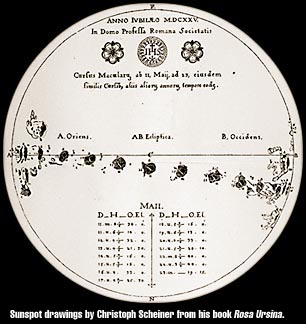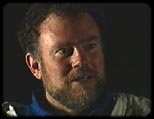|
|
|||||
|
Sunspot Controversies |
|
||||
| According to Dearborn, "In Europe, where the telescope was first invented and used, it informed them that sunspots existed. There was a belief that the heavens were perfect, and frequently people see only what they expect to see. So when they first saw sunspots, they were amazed. They didn't really know what sunspots were, because they didn't have the tools to measure the magnetic fields that were producing these things, but they definitely sparked curiosity." |
|
|
| Who saw them first? There is some debate over which European was first to discover sunspots. The credit is usually shared by Johann Goldsmid (known as Johannes Fabricius) of Holland, Galileo Galilei of Italy, Christopher Schiener of Germany, and Thomas Herriot of England, all of whom claimed to have discerned sunspots sometime in 1611. All four men observed sunspots through telescopes, and made drawings of the changing shapes by hand, watching the spots traverse the visible surface of the sun. These drawings were the first steps toward understanding sunspots. |
||
 |
Heavens...flawed? But these scientists could not agree on what they were seeing. Some, like Galileo, believed that sunspots were part of the sun itself, features like spots or clouds. But other scientists, especially Schiener, who was a Jesuit priest, believed the Catholic Church's doctrine that the heavens were perfect, representing the divine perfection of God. |
This doctrine is often seen as an extension of Aristotle's view of the heavens as ideal and unchanging. To admit that the sun had spots or blemishes that moved and changed would be to undermine that perfection! So Schiener argued that the spots he and Galileo were seeing must be planets or moons orbiting the sun, and he interpreted his observations in the light of that argument. |
|
| Learning by observation Galileo, perhaps less entangled in the doctrine of the period, made a breakthrough. By observing the sun closely over a period of several weeks, Galileo noticed the shape of the sunspots became foreshortened, or compacted, as they approached the edge of the visible sun. He realized that this would only happen if the spots were like flat objects on the surface of the sun, and were turning their edges to Earth as the Sun rotated. You can simulate Galileo's observation yourself by taping a coin to a globe, and rotating the globe. How does the shape of the coin appear to change? This would not happen if the sunspots were spherical planets or moons passing before the sun. So Galileo concluded that the spots must be on the surface. Though he admitted that he was unsure what the spots were, he suggested that they could be clouds. |
|
|
|||||
|
|
|||||
|
ęCopyright 2001 Regents of the University of California. |
